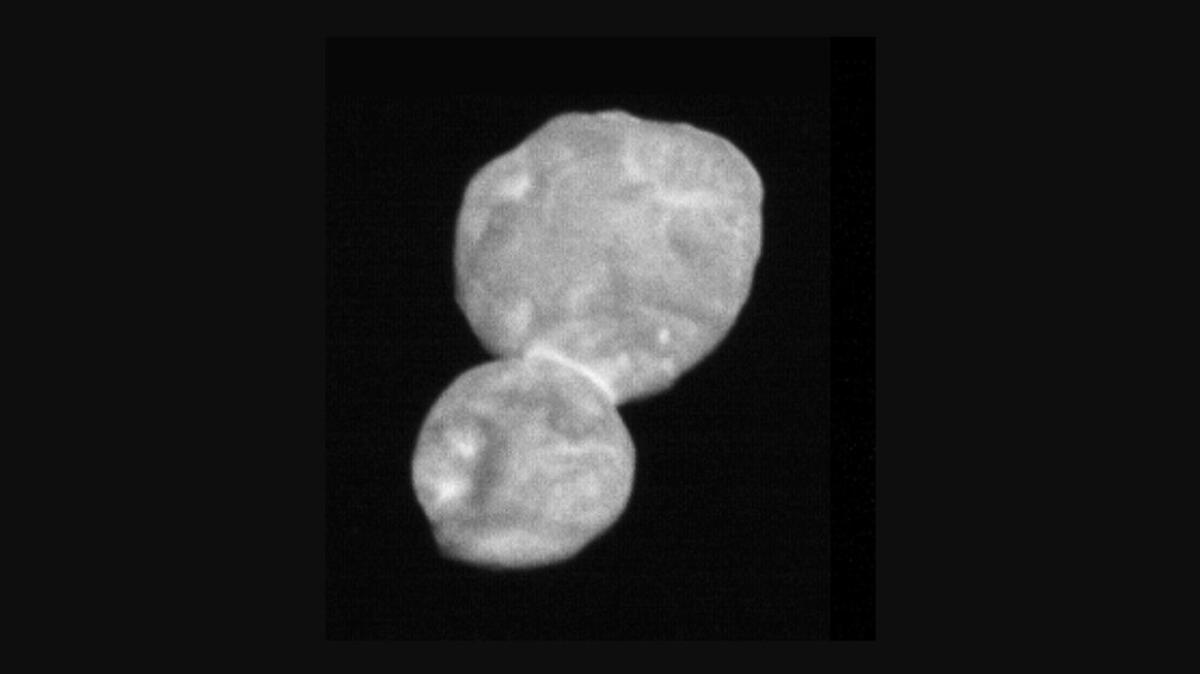Meet Ultima Thule: Dark as potting soil and shaped like a snowman, first images reveal

- Share via
It’s rust-colored and lumpy. It’s about as dark as potting soil. And shaped like a snowman.
Two days after NASA’s New Horizons spacecraft hurtled past a small, frozen world 4.5 billion miles from Earth, Ultima Thule is finally coming into focus.
“What we are seeing is the first contact binary ever explored by a spacecraft,” Alan Stern, the mission’s principal investigator, said Wednesday as he revealed new images from the spacecraft. “These are two completely separate objects.”
Although the pictures are still a bit fuzzy, it is clear that the Kuiper belt object consists of two circular lobes held together by gravity and a thin neck of material.
One of the lobes is about three times the size of the other one. The members of the science team, who have not had a lot of sleep over the last several days, nicknamed the larger lobe “Ultima” and the smaller one “Thule.”
“It’s pretty easy to remember,” said Stern, who is based at the Southwest Research Institute in Boulder, Colo.
The new images came down to Earth on Tuesday evening, so scientists have not had much time to analyze them. But already, they said, their first close-up view of Ultima Thule confirms current theories about how the planets of our solar system first came into being.
Both parts of Ultima Thule are spherical, and researchers say they probably formed from small particles in the original solar disk of gas and dust that came together in a process known as accretion.
Once the two distinct objects reached their present size, they slowly collided at a speed of less than 1 mile per hour, said Jeff Moore, the geology and geophysics lead for New Horizons who is based at NASA’s Ames Research Center in the Bay Area.
“They came together at such a gentle speed that they are really sort of resting on each other,” Moore said.
Scientists have theorized that all objects in the solar system probably formed in a similar way, but they never had the opportunity to study these primordial structures until now.
Several comets that have flown into the inner solar system have had a bilobed shape, but it was unclear whether they were formed that way or took that shape as ices on their surface sublimated away in the warmth of the sun.
Ultima Thule, on the other hand, has remained in he Kuiper belt’s deep freeze for billions of years, receiving 900 times less sunlight than Earth.
“What we are looking at is the first planetesimals,” Moore said. “These are the only remaining building blocks of the planets, scattered in the backyard of the solar system.”

The new images also revealed significant color variation on Ultima Thule’s surface. The darkest patches reflect just 6% of the sun’s light, while the brightest patches reflect up to 13% of the light. At times, these two extremes can be seen right next to each other.
Cathy Olkin, a New Horizons science investigator from the Southwest Research Institute, pointed out that the most reflective region of the object is a thin band around its neck.
That’s probably because fine-grained materials rolled down the slopes of the two lobes and settled in the space in between, she said. Small components tend to be more reflective than larger ones, she added.
Scientists have also determined that Ultima Thule is rotating at a rate of about once every 15 hours, give or take an hour, and confirmed that its surface is deep red. They are not yet sure what the surface is made of, however.
“As we are speaking, data is streaming down that will allow us to map the surface composition,” Olkin said. “That’s definitely what I’m most excited about today.”
Stern said the images unveiled Wednesday were just a small taste of the vast amounts of data that New Horizons will transmit in the coming weeks and months.
This initial look at Ultima Thule was taken from a distance of about 30,000 miles, when the spacecraft was zooming toward the small, distant world. At the moment of closest approach, New Horizons came within 2,200 miles of the surface.
“Everything we are telling you is just the tip of the iceberg,” he said. “Far less than 1% of the data is already down on the ground.”
The new images revealed that Ultima Thule’s topography rises and falls by about a mile in height, but whether those differences in elevation are due to craters or mountains and hills is still to be determined. Future images taken from different angles will allow scientists to analyze the shadows falling on Ultima Thule’s surface, which may help answer those questions.
Scientists will also look for opportunities to peer into the planetesimal’s interior and search for signs of layering, or regions with different chemical compositions.
And they’ll hunt for evidence of small moons or satellites orbiting Ultima Thule, which could help them determine its mass.
“It’s just going to get better and better,” Stern said.
Twitter: @DeborahNetburn




